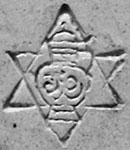
 |
However, over the next decade serious doubts were raised regarding the Girmscheid identification as multiple steins displaying the jug-in-hexagram mark were discovered bearing the same model numbers as totally different confirmed Girmscheid designs. Ultimately the evidence became so overwhelming that SCI published an article concluding that there was no longer any serious basis for the belief that the mark belonged to Girmscheid.1 At least in part, the conclusions in that article were based on research conducted in the course of compiling the Matthias Girmscheid Stein Catalog for the Beer Stein Library. Unfortunately, while at that point it had become reasonably clear who wasn’t responsible for the mark, there was virtually no available evidence pointing toward who was.
The Knoedgen “Rosetta Stein”
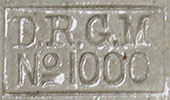 |
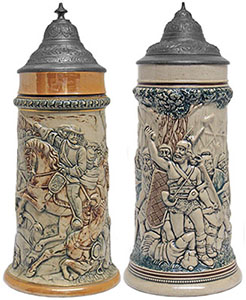 |
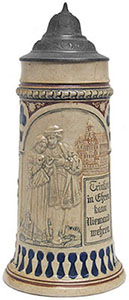 |
 |
Back to square one, and that’s where things stood until early 2014 and the appearance of the “Rosetta Stein”.
Shown in Fig. 4, the breakthrough stein was discovered in an eBay auction. Having no particularly noteworthy design features, not to mention a base chip, and an opening price set somewhat above market value, it went largely unnoticed by collectors, receiving only a single bid (i.e., mine). What attracted me to it were the two marks appearing on its base. One was the “D.R.G.M. No. 1000” discussed above, and the other, seen in Fig. 5, showed the initials “JLK”. Much like the clues to translating Egyptian hieroglyphics provided by having the same text in multiple languages on the ancient Rosetta Stone, the proximity of one mark to the other on the base of the eBay stein ultimately provided the key to identifying the elusive jug-in-hexagram mark.
A brief search in the indispensable Keramic-Marken Lexikon revealed only a single Westerwald beer stein producer with the initials JLK — Jakob Leopold Knoedgen (or Knödgen) GmbH & Co., located in the town of Ransbach (now Ransbach-Baumbach).2 However, after some preliminary research produced the conclusion that no German company had operated under that name for at least the prior two decades, the problem then became one of confirming the thesis that the newly discovered JLK mark, and hence the jug-in-hexagram mark, had been applied a century or more earlier at the Knoedgen factory.
To make a long story short, with the help of my good friend Hans Günster, Gesch�ftsf�hrer (CEO) of steinmaker KING-Werk in Höhr-Grenzhausen, contact was made with Leo Knödgen, the now-retired grandson of the original J.L. Knoedgen, who was able to confirm that both the JLK and jug-in-hexagram marks were indeed indicative of Knoedgen designs.3 Mystery resolved!
About the Company
Sadly, although the Ransbach factory continues in operation today as Römertopf Keramik GmbH & Co., a maker of ceramic cookware, no Knoedgen historical documents (catalogs, etc.) appear to have survived the transition. That’s not to say they don’t exist, but it can be stated with some degree of certainty that they’re not to be found in the hands of either Römertopf or any known Knoedgen heirs.
According to the Keramic-Marken Lexikon, the company was founded by J.L. Knoedgen in 1892 as the “first Ransbach stoneware and terracotta products factory” and by 1910 the firm had grown to employ some 45 workers.
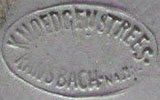 |
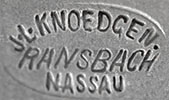 |
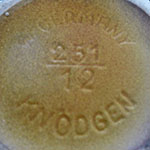 |
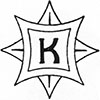 |
Subsequent to the May 1949 creation of the Federal Rupublic of Germany (or “West Germany”), Knoedgen introduced a new marking system, an example of which is shown in Fig. 8. The two part identifier (i.e., nnn/nn) uses a system adopted by several Westerwal manufacturers during that period, showing the model number above the line and below it the height of the item stated in centimeters. The model numbers applied to articles produced during this period are unrelated to those found on Knoedgen’s pre-WWII beer steins.
I have so far seen only a single stein marked in this manner, and given the limited period of time during which it could have been applied before Knoedgen got out of the stein-making business (i.e., May 1949-1950), my expectation is that few additional examples are likely to be discovered.
Be that as it may, by 1995 the company had been sold, and that’s pretty much all we currently know about the history of J.L. Knoedgen.
However, before leaving this topic it’s worth pointing out that at least one additional base mark has been associated with the firm. The mark seen in Fig. 9 is credited to Knoedgen in the Keramic-Marken Lexikon6, with stated usage dates of 1910-1927. Whether or not the mark was ever applied to beer steins is currently unknown, but it can’t hurt to keep it in mind, just in case….
Handles
In addition to base marks, another highly reliable tool for determining the origin of a particular beer stein is the handle. Although it’s possible to find some overlap between manufacturers, that’s a relatively rare occurrence, so as many Beer Stein Library members have discovered, if the handle can be identified, it’s effectively as good as a maker’s mark. Some of the handles that have been encountered on J.L. Knoedgen steins are shown in Fig. 10, below. A more current and comprehensive look at known Knoedgen handles can be found in the online Westerwald Beer Stein Handle Gallery.
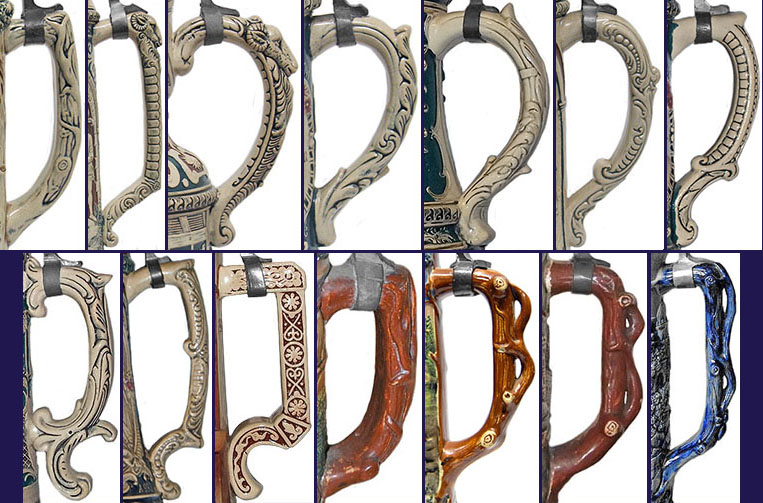 |
Each of the handles pictured here has been seen at least once in conjunction with one or more of the confirmed Knoedgen base marks, and so may be assumed to be an accurate JLK identifier.
Knoedgen Figurals?
 |
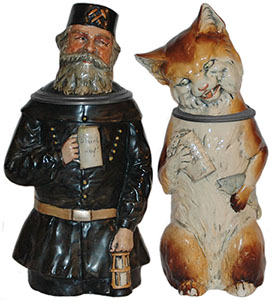 |
Shortly after I was made aware of the article, an image of the JLK/R mark was sent to Leo Knödgen in Germany, along with photos of a half-dozen of the figural steins in the group on which it had appeared. His response9 came back as follows (translated):
 |
Since Herr Knoedgen had been able to attest to his firm’s use of the jug-in-hexagram and other JLK base marks dating back to essentially the same time period, the fact that he failed to recognize the steins that carried the JLK/R mark, and by inference the mark itself, at the very least casts some serious doubt on the assertion that the mark was applied at the Knoedgen factory.
In the similar vein, it’s also worth noting that all of the steins in this group have the relatively plain handle shown in Fig. 13. That handle has, so far at least, not been seen on any confirmed Knoedgen beer stein.
Another thing to consider is the fact that the maker’s mark on antique beer steins is rarely found anywhere other than on the base. In better than 17 years spent compiling the catalogs in the Beer Stein Library, and substantially longer as a collector, the only manufacturer’s mark I can recall seeing on the bodies of antique beer steins appeared on a handful of early (i.e., circa 1883) Dümler & Breiden pieces — a practice that was quickly discontinued.10 Moreover, it’s a typical, if not universal, characteristic of monograms that the last name of the owner is represented by the dominant initial, so in this case it seems likely that the owner had a last name beginning with “L” rather than “K” (i.e., “JKL” as opposed to “JLK”).
All that being said, it’s important to point out that each of these arguments suffers from what logicians would call the “negative proof fallacy”. None of them necessarily disprove the contention that the JLK/R mark belonged to the J.L. Knoedgen company. However, taken together they certainly point to the conclusion that acceptance of that contention as fact without additional evidence would, at best, be premature.
An Online J.L. Knoedgen Catalog
Once the jug-in-hexagram mark was initially identified, we began working toward the goal of developing a Knoedgen catalog that could eventually be added to the Beer Stein Library. As this is written, I’m pleased to report that the goal has become a reality, and that Library members now have access to the first and only J.L. Knoedgen Stein Catalog. Of course, at this stage it’s only a beginning. Readers who own steins displaying any of the base marks or handles shown above are urged to support this ongoing effort by submitting photographs to [email protected]. If you can help, please don’t sit on the sidelines.
___________
1 “I can’t tell you who made it, but...This is Not a Girmscheid Mark”, Walter Vogdes, Prosit, Vol. 2, No. 71, September 2009, p. 4.
2 Zühlsdorff, Dieter: Keramik-Marken Lexikon (Ceramic Marks Encyclopedia); Arnoldsche, Stuttgart; 1994. p. 591.
3 Fax to Johannes Günster from Leo Knödgen dated 25 April 2014.
4 Reported telecom between Johannes Günster and Leo Knödgen, 15 January 2015.
5 Fax to Johannes Günster from Leo Knödgen dated 25 April 2015.
6Zühlsdorff, Dieter: op. cit. at page 345.
7 “Mystery Mark Identified!”, posting on the “What’s New” page in the Beer Stein Library, 5 May 2014 (since removed).
8 “Manufacturer Discovered”, Arvid Frende, Prosit, Vol. 2, No. 91, September 2014, p. 3.
9 Fax to Johannes Günster from Leo Knödgen dated 8 October 2014.
10 Collector’s Guide to Dümler & Breiden Beer Steins, Frank Loevi, Beer Stein Library.
__________
Many thanks to:
Hans Günster for his efforts in tracking down and establishing a communications link with Leo Knödgen, grandson of the founder and last CEO of J.K. Knoedgen, GmbH & Co., and of course to Herr Knoedgen himself for taking the time to respond to our inquiries. Without them both, the mystery of the jug-in-hexagram mark would still be unresolved;
John Hataloski, whose extensive collection yielded the two steins shown in Fig. 3, which ultimately provided a critical link in the discovery process; and
Ron Fox, editor of Prosit, for providing the images appearing in Figs. 11, 12 and 13.
__________
© 2014-2015 Beer Stein Library — All rights reserved.